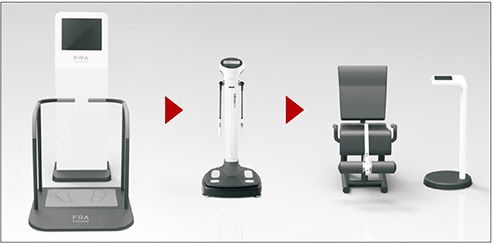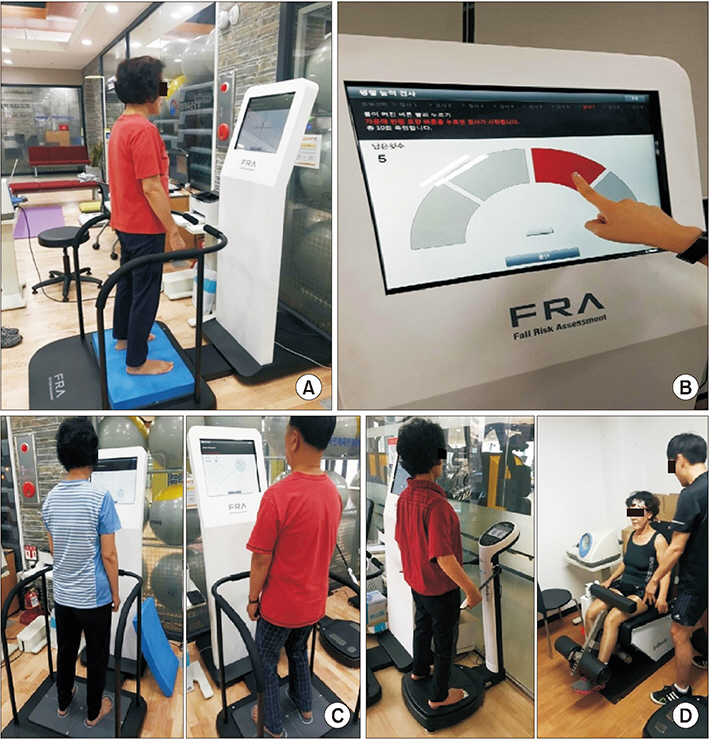Ann Rehabil Med.
2019 Feb;43(1):87-95. 10.5535/arm.2019.43.1.87.
Introduction of Fall Risk Assessment (FRA) System and Cross-Sectional Validation Among Community-Dwelling Older Adults
- Affiliations
-
- 1Department of Family Medicine, Kyung Hee University Medical Center, Seoul, Korea. chunwon62@naver.com
- 2Department of Biomedical Science and Technology, Graduate School of Kyung Hee University, Seoul, Korea.
- 3East-West Medical Research Institute, Kyung Hee University Medical Center, Seoul, Korea.
- 4Department of Physical Medicine and Rehabilitation, Kyung Hee University Medical Center, Seoul, Korea.
- 5Statistics Support Department, Medical Science Research Institute, Kyung Hee University Medical Center, Seoul, Korea.
- 6Elderly Frailty Research Center, Kyung Hee University Medical Center, Seoul, Korea.
- KMID: 2440956
- DOI: http://doi.org/10.5535/arm.2019.43.1.87
Abstract
OBJECTIVE
To predict the risk of falls, Fall Risk Assessment (FRA) system has been newly developed to measure multi-systemic balance control among community-dwelling older adults. The aim of this study was to examine the association between FRA and fall-related physical performance tests.
METHODS
A total of 289 community-dwelling adults aged 65 years and older participated in this cross-sectional study. All participants underwent FRA test and physical performance tests such as Short Physical Performance Battery (SPPB), Berg Balance Scale (BBS), and Timed Up and Go Test (TUG).
RESULTS
Participants who were younger, male, highly educated, living with family members, having high body mass index, having high appendicular lean mass index, and having no irritative lower urinary tract syndrome were more likely to have higher FRA scores. SPPB (β=1.012), BBS (β=0.481), and TUG (β=-0.831) were significantly associated with FRA score after adjusting for the variables (all p < 0.001).
CONCLUSION
FRA composite score was closely correlated with SPPB, BBS, and TUG, suggesting that FRA is a promising candidate as a screening tool to predict falls among community-dwelling elderly people.
Keyword
MeSH Terms
Figure
Reference
-
1. Tinetti ME, Williams CS. Falls, injuries due to falls, and the risk of admission to a nursing home. N Engl J Med. 1997; 337:1279–84.
Article2. Tinetti ME, Williams CS. The effect of falls and fall injuries on functioning in community-dwelling older persons. J Gerontol A Biol Sci Med Sci. 1998; 53:M112–9.
Article3. Hill-Westmoreland EE, Soeken K, Spellbring AM. A meta-analysis of fall prevention programs for the elderly: how effective are they? Nurs Res. 2002; 51:1–8.4. Gillespie LD, Robertson MC, Gillespie WJ, Sherrington C, Gates S, Clemson LM, et al. Interventions for preventing falls in older people living in the community. Cochrane Database Syst Rev. 2012; (9):CD007146.
Article5. Mangani I, Cesari M, Russo A, Onder G, Maraldi C, Zamboni V, et al. Physical function, physical activity and recent falls. Results from the “Invecchiamento e Longevità nel Sirente (ilSIRENTE)” Study. Aging Clin Exp Res. 2008; 20:234–41.
Article6. Veronese N, Bolzetta F, Toffanello ED, Zambon S, De Rui M, Perissinotto E, et al. Association between Short Physical Performance Battery and falls in older people: the Progetto Veneto Anziani Study. Rejuvenation Res. 2014; 17:276–84.
Article7. Shumway-Cook A, Baldwin M, Polissar NL, Gruber W. Predicting the probability for falls in communitydwelling older adults. Phys Ther. 1997; 77:812–9.
Article8. Muir SW, Berg K, Chesworth B, Speechley M. Use of the Berg Balance Scale for predicting multiple falls in community-dwelling elderly people: a prospective study. Phys Ther. 2008; 88:449–59.
Article9. Podsiadlo D, Richardson S. The timed “Up & Go”: a test of basic functional mobility for frail elderly persons. J Am Geriatr Soc. 1991; 39:142–8.10. Mancini M, Horak FB. The relevance of clinical balance assessment tools to differentiate balance deficits. Eur J Phys Rehabil Med. 2010; 46:239–48.11. Muir SW, Berg K, Chesworth B, Klar N, Speechley M. Quantifying the magnitude of risk for balance impairment on falls in community-dwelling older adults: a systematic review and meta-analysis. J Clin Epidemiol. 2010; 63:389–406.
Article12. Moreland JD, Richardson JA, Goldsmith CH, Clase CM. Muscle weakness and falls in older adults: a systematic review and meta-analysis. J Am Geriatr Soc. 2004; 52:1121–9.
Article13. Frank-Wilson AW, Farthing JP, Chilibeck PD, Arnold CM, Davison KS, Olszynski WP, et al. Lower leg muscle density is independently associated with fall status in community-dwelling older adults. Osteoporos Int. 2016; 27:2231–40.
Article14. Lord SR, Menz HB, Tiedemann A. A physiological profile approach to falls risk assessment and prevention. Phys Ther. 2003; 83:237–52.
Article15. Delbaere K, Close JC, Heim J, Sachdev PS, Brodaty H, Slavin MJ, et al. A multifactorial approach to understanding fall risk in older people. J Am Geriatr Soc. 2010; 58:1679–85.
Article16. Harro CC, Garascia C. Reliability and validity of computerized force platform measures of balance function in healthy older adults. J Geriatr Phys Ther;2018.17. Prometti P, Olivares A, Gaia G, Bonometti G, Comini L, Scalvini S. Biodex fall risk assessment in the elderly with ataxia: a new age-dependent derived index in rehabilitation. An observational study. Medicine (Baltimore). 2016; 95:e2977.18. Kim M, Kim S, Won CW. Test-retest reliability and sensitivity to change of a new fall risk assessment system: a pilot study. Ann Geriatr Med Res. 2018; 22:80–7.
Article19. Tinetti ME, Speechley M, Ginter SF. Risk factors for falls among elderly persons living in the community. N Engl J Med. 1988; 319:1701–7.
Article20. Han BI, Lee HW, Kim TY, Lim JS, Shin KS. Tinnitus: characteristics, causes, mechanisms, and treatments. J Clin Neurol. 2009; 5:11–9.
Article21. Guralnik JM, Simonsick EM, Ferrucci L, Glynn RJ, Berkman LF, Blazer DG, et al. A short physical performance battery assessing lower extremity function: association with self-reported disability and prediction of mortality and nursing home admission. J Gerontol. 1994; 49:M85–94.
Article22. Shumway-Cook A, Brauer S, Woollacott M. Predicting the probability for falls in community-dwelling older adults using the Timed Up & Go Test. Phys Ther. 2000; 80:896–903.23. Schoene D, Wu SM, Mikolaizak AS, Menant JC, Smith ST, Delbaere K, et al. Discriminative ability and predictive validity of the timed up and go test in identifying older people who fall: systematic review and meta-analysis. J Am Geriatr Soc. 2013; 61:202–8.
Article24. Chaikeeree N, Saengsirisuwan V, Chinsongkram B, Boonsinsukh R. Interaction of age and foam types used in Clinical Test for Sensory Interaction and Balance (CTSIB). Gait Posture. 2015; 41:313–5.
Article25. Laroche DP, Knight CA, Dickie JL, Lussier M, Roy SJ. Explosive force and fractionated reaction time in elderly low- and high-active women. Med Sci Sports Exerc. 2007; 39:1659–65.
Article26. Lord SR, Ward JA, Williams P, Anstey KJ. Physiological factors associated with falls in older communitydwelling women. J Am Geriatr Soc. 1994; 42:1110–7.
Article27. Ward RE, Leveille SG, Beauchamp MK, Travison T, Alexander N, Jette AM, et al. Functional performance as a predictor of injurious falls in older adults. J Am Geriatr Soc. 2015; 63:315–20.
Article28. Peterka RJ. Sensorimotor integration in human postural control. J Neurophysiol. 2002; 88:1097–118.
Article29. Boulgarides LK, McGinty SM, Willett JA, Barnes CW. Use of clinical and impairment-based tests to predict falls by community-dwelling older adults. Phys Ther. 2003; 83:328–39.
Article
- Full Text Links
- Actions
-
Cited
- CITED
-
- Close
- Share
- Similar articles
-
- Test-retest Reliability and Sensitivity to Change of a New Fall Risk Assessment System: A Pilot Study
- Development of a Knowledge Scale of Fall Risk Factors for Community-dwelling Older Adults
- Influence of Advance Directives' Self-efficacy of Community-dwelling Older Adults on the Completion of Advance Directives: Mediating the Effect of Intention for Advance Directives: A Cross-Sectional Study
- Fall Risk Home Environment and Fall Experiences among Community-Dwelling Older People
- Comparison of Comprehensive Health Status and Health-related Quality of Life between Institutionalized Older Adults and Community Dwelling Older Adults



